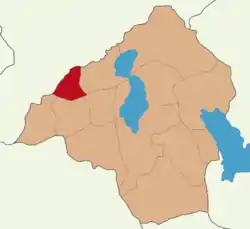Sozopolis (Pisidia)
Sozopolis in Pisidia (Ancient Greek: Σωζόπολη της Πισιδίας), which had been called Apollonia (Ἀπολλωνία) and Apollonias (Ἀπολλωνίας)[1] during Seleucid times, was a town in the former Roman province of Pisidia, and is not to be confused with the Thracian Sozopolis in Haemimonto in present-day Bulgaria.
Location

Sozopolis in Pisidia must have been situated in the border region of that province, since some ancient accounts place it in Phrygia.[2] Its site may correspond to present-day Uluborlu in Isparta Province, Turkey.[3] Older sources put it "Souzon, south of Aglasoun".[4] Modern scholars locate its site near Uluborlu, Isparta Province.[5][6]
History
Stephanus of Byzantium says that Apollonia in Pisidia (Sozopolis) was originally called Mordiaeon or Mordiaïon (Μορδιάιον), and was celebrated for its quinces.[7][8] The coins of Apollonia record Alexander the Great as the founder, and also the name of a stream that flowed; by it, the Hippopharas.[9][10] Two Greek inscriptions of the Roman period copied by Francis Arundell give the full title of the town in that age, "the Boule and Demus of the Apolloniatae Lycii Thraces Coloni," by which he concluded that the city was founded by a Thracian colony established in Lycia, but that conclusion is not universally accepted.[9]
Sozopolis in Pisidia was the birthplace of Severus of Antioch (born around 456).[11]
The icon of the Theotokos of Pisidian Sozopolis, celebrated by Eastern Orthodox Christians on 3 September, originated in this city.[12]
Fragments of the Res Gestae Divi Augusti in Greek have been found in the area.
Bishopric
Sozopolis sent its bishop and possibly two other representatives to the Council of Constantinople in 381,[2] and its bishop attended the Council of Ephesus in 431.[13]
The see is included in the Catholic Church's list of titular sees.[3]
References
- Strabo. Geographica. p. 576. Page numbers refer to those of Isaac Casaubon's edition.
- Getzel M. Cohen, The Hellenistic Settlements in Europe, the Islands, and Asia Minor (University of California Press 1995 ISBH 978-0-52091408-7), p. 289
- Annuario Pontificio 2013 (Libreria Editrice Vaticana, 2013, ISBN 978-88-209-9070-1), p. 975
- Philip Schaff (editor), Basil the Great: Letters and Select Works, note to Letter CCLXVI of Saint Basil (to the Sozopolitans)
- Richard Talbert, ed. (2000). Barrington Atlas of the Greek and Roman World. Princeton University Press. p. 65, and directory notes accompanying.
- Lund University. Digital Atlas of the Roman Empire.
- Stephanus of Byzantium. Ethnica. s.v. Ἀπολλωνία.
- Athen. III 81 Α
-
 Smith, William, ed. (1854–1857). "Apollonia". Dictionary of Greek and Roman Geography. London: John Murray.
Smith, William, ed. (1854–1857). "Apollonia". Dictionary of Greek and Roman Geography. London: John Murray. - Gustav Hirschfeld: Apollonia 21.(in German) In: Realencyclopädie der classischen Altertumswissenschaft (RE). Volume II, 1, Stuttgart 1893ff., col. 116.
- Pauline Allen, C.T.R Hayward, Severus of Antioch (Routledge 2004 ISBN 978-1-13456780-5)
- September 3 (Eastern Orthodox liturgics)
- John Chapman, "Monophysites and Monophysitism" in Catholic Encyclopedia (New York 1911)
![]() This article incorporates text from a publication now in the public domain: Smith, William, ed. (1854–1857). "Apollonia". Dictionary of Greek and Roman Geography. London: John Murray.
This article incorporates text from a publication now in the public domain: Smith, William, ed. (1854–1857). "Apollonia". Dictionary of Greek and Roman Geography. London: John Murray.